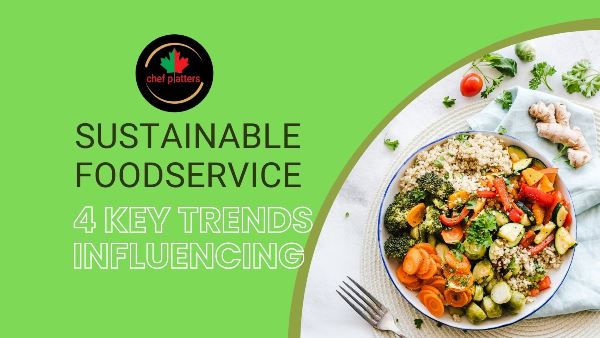4 Key Trends Influencing the Progression of Sustainable Foodservice

As consumers place more importance on sustainability, operators need to consider trends shaping the future of sustainable foodservice
Food waste can be cut down by utilizing consumer-friendly food protection and preservation ingredients that deliver food safety and less food waste by prolonging shelf life.
Fast Facts:
More than half of North American consumers value sustainability when making restaurant purchasing decisions.
In today’s market, this is very important food service. Food operators understand how to implement the basics of sustainability such as environmentally friendly packaging and ingredients.
CareDigest research highlights 4 key areas of opportunity for brands to create products with improved sustainability—and increased consumer appeal.
The full scoop:
Sustainability isn’t the only thing that matters to consumers:
As sustainability increasingly becomes a key factor for success in the foodservice industry, recent studies underscore its significance. According to the CareDigest 2021 Sustainability in Motion report, 58% of North American consumers prioritize sustainability when making food or drink purchases at restaurants. This underscores the pressing need for the industry to adopt more sustainable practices.
In response to this trend, restaurant operators are revamping their menus. Data from DataCentential reveals a notable uptick in mentions of sustainable menu items across various dining establishments, particularly in fine dining and fast-casual restaurants over the past four years. This includes an increase in offerings made from sustainable and locally sourced ingredients, alongside environmentally friendly packaging alternatives.
In order to cater to the growing demand for sustainable options, foodservice operators can align with these culinary trends that promote sustainable nutrition.
Implementing changes behind the scenes, such as adopting products with environmentally friendly packaging certified by the Forest Stewardship Council (FSC), can yield positive environmental benefits for both distributors and operators.
1. Reduce food waste
A more sustainable food service starts with the basics: reducing environmental impact. Both food waste and food production contribute to a company’s carbon footprint. Food service companies are encouraged to make choices that positively impact the environment, not just on their menus, but throughout the supply chain.
Partnering with companies that offer sustainable products made through sustainable processes is one way brands can quickly improve the sustainability of their offerings. Sustainable sourcing, clean ingredients, ethical production and humane working conditions can all help a product earn the “sustainable” label and give foodservice operators the opportunity to provide more transparency to consumers.
Food waste can be reduced by using consumer-friendly food safety and preservation ingredients that provide food safety and extend shelf life, resulting in less food waste. These solutions can improve back-of-house efficiency for foodservice operators. For example, switching to dry beverage solutions can reduce food waste due to the product’s extended shelf life and, because such products often use less packaging and do not require refrigeration, they can also reduce carbon emissions and waste in the supply chain.
2. Offering meatless and dairy-free menu options
Our research suggests that the importance of sustainability varies by category. The top categories include dairy, meat and plant-based alternatives, with 75% of consumers specifically looking for sustainability in plant-based dairy and meat alternatives. Datasential also shows that 20% of foodservice operators have sustainability in mind when offering plant-based protein.
Given the rise of flexi and increasing consumer awareness of the earth’s natural resources and animal and human welfare, adding plant-based menu options meets consumer expectations of sustainability across the board. Consumers want more plant-based options and they want them to taste better. Operators considering meatless or dairy-free on their menus will want to overcome the common barriers associated with these types of offerings by using consumer-preferred plant-based ingredients in their offerings.
3. Balancing taste with sustainable nutrition
After all, consumers want their food and beverage choices to taste good and nourish them. In our research, we found 73% of North American consumer’s now associate health and nutrition with sustainability. Consumers perceive behaviors such as healthy eating and exercise as tied to sustainability. As a result, foodservice operators are being called upon to offer menu items that not only taste great but also provide sustainable nutrition, addressing the nutritional, environmental and social impact of food.
Offering products with less sugar is one way brands can incorporate sustainable nutrition into their menus. By reducing sugar, they can improve the nutrition of food and beverages and also provide lower greenhouse gas and water impacts. Using sustainable sweet and savory flavor products can also increase consumer appeal of foodservice products. Creating products fortified with wellness ingredients like probiotics or added proteins is an additional way to create a circular process that eliminates waste as demand grows.
4. Innovation with eco-friendly packaging and disposables
According to Unilever, 30% of municipal solid waste comes from discarded packaging, and restaurants contribute a significant amount.
Implementing changes behind the scenes, such as adopting products with environmentally friendly packaging certified by the Forest Stewardship Council (FSC), can yield positive environmental benefits for both distributors and operators.
On the home front, switching to compostable or biodegradable disposables, such as straws and containers made from materials such as sugarcane, bamboo and PLA plastic and paper, can help make a difference.
Pushing the boundaries of sustainability, certain restaurants are now providing reusable to-go containers.Tiffin Indian Cuisine in Philadelphia, PA offers takeout containers that can be returned, washed and reused, and Mixt in San Francisco offers stainless steel salad bowls for takeout and delivery that are then collected, sanitized and reused.
Restaurants are gradually implementing these types of programs in an effort to reduce packaging waste.
Final Thoughts
As consumers increasingly prioritize sustainability, foodservice operators must adapt to trends shaping the industry’s future. Notably, 58% of North American consumers consider sustainability when dining out. Embracing sustainable practices, including menu revamps and eco-friendly packaging, is vital for success. Innovative initiatives like reusable to-go containers are emerging, reflecting this commitment.




